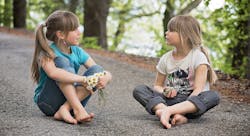Two studies published in the Journal of the Pediatric Infectious Diseases Society describe the presentation of the COVID-19-related multisystem inflammatory syndrome in children (MIS-C) and how heavy coronavirus exposure didn't lead to infection in four siblings aged nine to 12 years, according to a news report from the Center for Infectious Disease Research and Policy (CIDRAP) at the University of Minnesota.
In addition, an expert review in the same journal recommends best practices for the use of antiviral drugs in infected children.
In the first study, researchers at Temple University in Philadelphia conducted a systematic review and meta-analysis of 16 case reports and series involving 505 children with MIS-C from June 3 to July 23. Thirty-two children (14.7 percent) had characteristic MIS-C signs and symptoms but tested negative for SARS-CoV-2, the virus that causes COVID-19, on reverse transcription polymerase chain reaction (RT-PCR), antibody testing, or both. The rest tested positive.
The most common signs and symptoms were fever (100 percent), gastrointestinal distress (88 percent), rash (59.2 percent), conjunctivitis ("pink eye") (50 percent), swollen lips and/or tongue (55.7 percent), swollen and/or red hands or feet (47.5 percent), and swollen lymph nodes in the neck (42.5 percent). The latter five signs are characteristic of Kawasaki disease, which is believed to be distinct from MIS-C. Another Kawasaki sign, skin peeling, was also observed in several patients. Median serum C-reactive protein (indicating inflammation) concentrations and fibrinogen and D dimer levels (indicating blood clots or inflammation) were elevated.
The most common treatments used were immune-boosting intravenous gamma globulin (78.1 percent) and the steroid methylprednisolone/prednisone (57.6 percent). Although blood clots requiring treatment occurred in only 3.5 percent of patients, 54.4 percent received anticoagulants. Major complications included heart muscle dysfunction requiring the use of inotropic agents to strengthen the heartbeat (57.4 percent) and oxygen added to the blood outside the body (5.3 percent), respiratory distress necessitating the use of mechanical ventilation (26.1 percent), and acute kidney injury (11.9 percent). Seven children (1.4 percent) died. Median patient age was 9 years (range, six months to 20 years).

